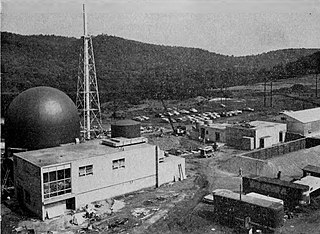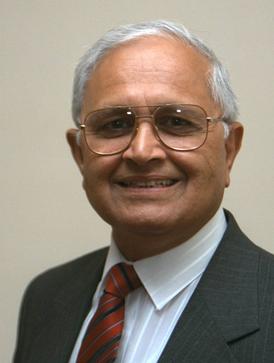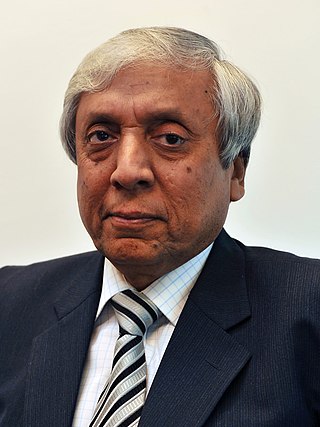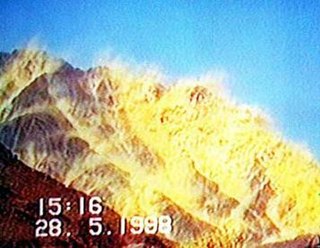The Kundian Nuclear Fuel Complex (KNFC) is a nuclear fuel manufacturing and fabrication plant located in Kundian in Mianwali District, Punjab, Pakistan. [1]
The plant is owned by the Pakistan Atomic Energy Commission (PAEC), which manufactures and, henceforth, supplies the nuclear fuel bundles and reactor cores to the nation's commercial nuclear power plant. It has an annual capacity of producing 24 megatonnes (2.4×1010 kg) of natural uranium oxide fuel as well as zirconium alloy cladding and reactor core components.: 115 [2]
The Kundian Nuclear Fuel Complex was established by the scientists and engineers working at the Pakistan Institute of Nuclear Science & Technology (Pinstech) in 1978. [3] Its establishment came after the Pakistani scientists discovered the heavy amounts of zirconium in the sandy beaches of Balochistan; the facility was established in Kundian in Mianwali District, Punjab, to separate other elements to procure the pure form of zirconium.: 115 [2] The nuclear reprocessing and experimental metallurgy of zirconium took place under Pinstech lab in its year early before the technology of nuclear fuel cycle was completely transferred to Kundian Nuclear Fuel Complex. [2]
The Kundian Nuclear Fuel Complex has an annual capacity of producing the 24 megatonnes (2.4×1010 kg) of natural uranium oxide fuel, which has allowed the Pakistan Atomic Energy Commission (PAEC) to run the grid operations of the Karachi Nuclear Power Plant (KANUPP) without the Canadian assistance at its full capacity.: 115 The Kundian Nuclear Fuel Complex manufactures 1500 Beryllium, Zirconium, and other metal oxide nuclear fuel bundles for Karachi Nuclear Power Plant as well as manufacturing the zirconium alloy cladding and reactor core components.: 115
According to the Pakistani government statistics, the indigenous nuclear fuel had saved Pakistan US$ 40 million years, with one PAEC mineralogist noting that: "Pakistan produced the first ton of [purified] uranium oxide and metal before it produced the first ton of copper or any other mineral using the local ore and indigenously developed technologies.: 115
The Kundian Nuclear Fuel Complex is located near the location of the Chashma Nuclear Power Plant. [3] [4]
A loss-of-coolant accident (LOCA) is a mode of failure for a nuclear reactor; if not managed effectively, the results of a LOCA could result in reactor core damage. Each nuclear plant's emergency core cooling system (ECCS) exists specifically to deal with a LOCA.

The light-water reactor (LWR) is a type of thermal-neutron reactor that uses normal water, as opposed to heavy water, as both its coolant and neutron moderator; furthermore a solid form of fissile elements is used as fuel. Thermal-neutron reactors are the most common type of nuclear reactor, and light-water reactors are the most common type of thermal-neutron reactor.

Nuclear fuel refers to any substance, typically fissile material, which is used by nuclear power stations or other nuclear devices to generate energy.

The Bhabha Atomic Research Centre (BARC) is India's premier nuclear research facility, headquartered in Trombay, Mumbai, Maharashtra, India. It was founded by Homi Jehangir Bhabha as the Atomic Energy Establishment, Trombay (AEET) in January 1954 as a multidisciplinary research program essential for India's nuclear program. It operates under the Department of Atomic Energy (DAE), which is directly overseen by the Prime Minister of India.

The Saxton Nuclear Experiment Station, also known as the Saxton Nuclear Generating Station or Saxton Nuclear Experimental Corporation Facility, was a small nuclear power plant located in Bedford County, near Saxton, Pennsylvania.

Pakistan Atomic Energy Commission (PAEC) is a federally funded independent governmental agency, concerned with research and development of nuclear power, promotion of nuclear science, energy conservation and the peaceful use of nuclear technology.
Chashma is located in Mianwali District near Kundian, Punjab, Pakistan. It is situated at the left bank of the river Indus, in close proximity of the Koh-i-Suleiman mountain range. Chashma is famous for the well-known Chashma Barrage built on the Indus River. Also nearby is the Chashma Nuclear Power Plant of the Pakistan Atomic Energy Commission, with two units of 300 megawatt CHASHNUPP-1 and CHASHNUPP-2 and two 325 megawatt CHASHNUPP-3 and CHASHNUPP-4. The four units of Chashma are amongst the best performing electricity generating plants in the country, in terms of endurance and availability..People referred as Chashmians.
The OK-150 reactor and its successor, the OK-900 reactor are Soviet marine nuclear reactors used to power ships at sea. They are pressurized water reactors (PWRs) that use enriched uranium-235 fuel. They have been used in various Russian nuclear-powered icebreaker ships. The reactor was developed by OKBM.
The Karachi Nuclear Power Plant is a large commercial nuclear power plant located at the Paradise Point in Karachi, Sindh, Pakistan.

The Pakistan Institute of Nuclear Science & Technology (PINSTECH) is a federally funded research and development laboratory in Nilore, Islamabad, Pakistan.
The Chashma Nuclear Power Plant is a large commercial nuclear power plant located at Chashma in Mianwali, Punjab, Pakistan.
In Pakistan, nuclear power is provided by six commercial nuclear power plants with a net capacity of 3,262 megawatts (3.262 GW) from pressurized water reactors. In 2021, Pakistan's nuclear power plants produced a total of 15.3 terawatt-hours of electricity, which accounted for roughly 10% of the nation's total electric energy generation.
Kundian, is a city of District Mianwali, Tehsil Piplan in the Punjab province of Pakistan. It is located near the Chashma Colony, Chashma, which also has the CHASNUPP Nuclear Power Plant.
The Pakistan Nuclear Power Fuel Complex (PNPFC), also known as Chemical Processing Plant (CPP), is a nuclear fuel manufacturing and a fabrication plant located in about 175 km (109 mi) south of Islamabad, possibly in Faisalabad District in Punjab.
The Nuclear Fuel Complex (NFC) was established in 1971 as a major industrial unit of India's Department of Atomic Energy, as a nuclear plant also specializing in supply of nuclear fuel bundles and reactor core components. It is a unique facility where natural and enriched uranium fuel, zirconium alloy cladding and reactor core components are manufactured under one roof.

Munir Ahmad Khan, NI, HI, FPAS, was a Pakistani nuclear reactor physicist who is credited, among others, with being the "father of the atomic bomb program" of Pakistan for their leading role in developing their nation's nuclear weapons during the successive years after the war with India in 1971.

Parvez Butt, is a Pakistani mechanical engineer and public official who served as the chairman of the Pakistan Atomic Energy Commission from 2001 till 2006.

Ansar Pervaiz, also spelled as, HI, is a Pakistani scientist and a nuclear engineer who was the former chairman of the Pakistan Atomic Energy Commission (PAEC), and former chairman of the Board of Governors of International Atomic Energy Agency (IAEA). Pervaiz is widely given credit for establishing the nuclear engineering, nuclear physics and nuclear technology institutes within Pakistan.

Project-706, also known as Project-786 was the codename of a research and development program to develop Pakistan's first nuclear weapons. The program was initiated by Prime Minister Zulfiqar Ali Bhutto in 1974 in response to the Indian nuclear tests conducted in May 1974. During the course of this program, Pakistani nuclear scientists and engineers developed the requisite nuclear infrastructure and gained expertise in the extraction, refining, processing and handling of fissile material with the ultimate goal of designing a nuclear device. These objectives were achieved by the early 1980s with the first successful cold test of a Pakistani nuclear device in 1983. The two institutions responsible for the execution of the program were the Pakistan Atomic Energy Commission and the Kahuta Research Laboratories, led by Munir Ahmed Khan and Abdul Qadeer Khan respectively. In 1976 an organization called Special Development Works (SDW) was created within the Pakistan Army, directly under the Chief of the Army Staff (Pakistan) (COAS). This organization worked closely with PAEC and KRL to secretly prepare the nuclear test sites in Baluchistan and other required civil infrastructure.

The Pakistan Atomic Research Reactor or (PARR) are two nuclear research reactors and two other experimental neutron sources located in the PINSTECH Laboratory, Nilore, Islamabad, Pakistan.